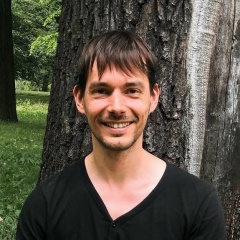Сварог.
Со священного языка арийцев санскрита, слово «сварог» переводится как «ходящий по небу». В давние времена им обозначали дневной путь солнца по небу, потом им стали называть небо вообще, небесный свет. Иными словами, сын Рода бог Сварог — это Отец Небесный. Иногда его называли просто Бог.
Сварог сварганил (сварил, создал) землю. Он нашел волшебный камень Алатырь, произнес магическое заклинание — камень вырос, стал огромным бел-горюч камнем. Бог вспенил им океан. Загустевшая влага стала первой сушей. В индийских Ведах это творение названо Пахтанием океана. Алатырь он использовал и для других важных целей: ударял по нему молотом — из разлетающихся во все стороны искр рождались новые боги и ратичи — небесные воины. В более поздние времена великий волшебник полуконь Китоврас (греки называли его кентавром Хироном) построил вокруг Алатыря храм в честь Всевышнего. Так появилось слово алтарь — самое святое место в храме.
Сварог научил людей готовить (творить) из молока творог и сыр, которые некогда считались священной едой, даром богов.
Бог создал и Синюю Сваргу — страну в небесах, где живут наши славные предки. Яркие звезды — это их сияющие очи, которыми деды и прадеды взирают с небес на наши земные дела. «Сварганить» до сих пор значит - чудесным, мастерским образом сотворить. Варить и «варганить» можно только при помощи огня и воды («вар» - санскр. вода). Сварог - источник огня и его повелитель. Он творит не словом, не магией в отличие от Велеса, а руками, он создает материальный мир. Он заботился о людях: дал им Солнце—Ра (отсюда наше слово радость) — и огонь, на котором можно было приготовить пищу и у которого можно было согреться в лютую стужу. Сварог сбросил с неба на землю плуг и ярмо, чтобы возделывать землю; боевую секиру, чтобы эту землю защищать от врагов, и чашу для приготовления в ней священного напитка.
Храм Всевышнего с алтарем-Алатырем стоял на склоне священной горы Эльбрус, высочайшей на Кавказе (5600 метров). В древности эту гору называли разными именами: Бел-Алабыр, Белая гора, Белина. Тут же протекает река Белая, а раньше стоял Белый город, где жил народ белогоров. Все названия в этих местах связаны с цветом Алатыря — белого камня, при ударе о который вылетали искры. В тех же краях до недавнего времени стоял величественный монумент великому славяно-русскому герою, потомку белогоров Бусу Белояру.
Возможно, одним из самых важных дел Отца Небесного стали созданные им Малое и Большое Кола (круги) времен — земных и космических. Сварог - бог-творец и законодатель, отец Сварожичей (Перуна, Даждьбога-Радегаста, Семаргла-Огня и Стрибога-Ветра), демиург, соотносимый с Гефестом, по мировоззрению, восходящему к орфической традиции.
Любая кузня, любой горн - это уже капище Сварога, потому при обустройстве капищ современному язычнику стоит помнить о том. При деревянном кумире Сварога должен гореть огонь, калиться металл, металлом должен быть обит и сам кумир. На капище Сварога должны быть молот (или железная тяжелая палка-лом) и наковальня. Именно Сварог начал железный век и научил людей пользоваться железными орудиями. Звуки приятны Сварогу - так как он первейший покровитель ремесел и всех мастеровитых - удары молоточков, звон цепей да завывание огня. Требы Сварогу приносят или сыром (сырниками) и творогом. Слово "творог" означает - сотворенный, оно однокоренное с именем Сварога, и является символом небесных хлебов. Роль кумира Сварогу может выполнять огромный камень, на котором нанесены символы огня.
День празднования его приходится на 14 ноября - Сварожки (день Кузьмы и Демьяна). Чтят и отца и сына - Сварожича-Огня.
Со священного языка арийцев санскрита, слово «сварог» переводится как «ходящий по небу». В давние времена им обозначали дневной путь солнца по небу, потом им стали называть небо вообще, небесный свет. Иными словами, сын Рода бог Сварог — это Отец Небесный. Иногда его называли просто Бог.
Сварог сварганил (сварил, создал) землю. Он нашел волшебный камень Алатырь, произнес магическое заклинание — камень вырос, стал огромным бел-горюч камнем. Бог вспенил им океан. Загустевшая влага стала первой сушей. В индийских Ведах это творение названо Пахтанием океана. Алатырь он использовал и для других важных целей: ударял по нему молотом — из разлетающихся во все стороны искр рождались новые боги и ратичи — небесные воины. В более поздние времена великий волшебник полуконь Китоврас (греки называли его кентавром Хироном) построил вокруг Алатыря храм в честь Всевышнего. Так появилось слово алтарь — самое святое место в храме.
Сварог научил людей готовить (творить) из молока творог и сыр, которые некогда считались священной едой, даром богов.
Бог создал и Синюю Сваргу — страну в небесах, где живут наши славные предки. Яркие звезды — это их сияющие очи, которыми деды и прадеды взирают с небес на наши земные дела. «Сварганить» до сих пор значит - чудесным, мастерским образом сотворить. Варить и «варганить» можно только при помощи огня и воды («вар» - санскр. вода). Сварог - источник огня и его повелитель. Он творит не словом, не магией в отличие от Велеса, а руками, он создает материальный мир. Он заботился о людях: дал им Солнце—Ра (отсюда наше слово радость) — и огонь, на котором можно было приготовить пищу и у которого можно было согреться в лютую стужу. Сварог сбросил с неба на землю плуг и ярмо, чтобы возделывать землю; боевую секиру, чтобы эту землю защищать от врагов, и чашу для приготовления в ней священного напитка.
Храм Всевышнего с алтарем-Алатырем стоял на склоне священной горы Эльбрус, высочайшей на Кавказе (5600 метров). В древности эту гору называли разными именами: Бел-Алабыр, Белая гора, Белина. Тут же протекает река Белая, а раньше стоял Белый город, где жил народ белогоров. Все названия в этих местах связаны с цветом Алатыря — белого камня, при ударе о который вылетали искры. В тех же краях до недавнего времени стоял величественный монумент великому славяно-русскому герою, потомку белогоров Бусу Белояру.
Возможно, одним из самых важных дел Отца Небесного стали созданные им Малое и Большое Кола (круги) времен — земных и космических. Сварог - бог-творец и законодатель, отец Сварожичей (Перуна, Даждьбога-Радегаста, Семаргла-Огня и Стрибога-Ветра), демиург, соотносимый с Гефестом, по мировоззрению, восходящему к орфической традиции.
Любая кузня, любой горн - это уже капище Сварога, потому при обустройстве капищ современному язычнику стоит помнить о том. При деревянном кумире Сварога должен гореть огонь, калиться металл, металлом должен быть обит и сам кумир. На капище Сварога должны быть молот (или железная тяжелая палка-лом) и наковальня. Именно Сварог начал железный век и научил людей пользоваться железными орудиями. Звуки приятны Сварогу - так как он первейший покровитель ремесел и всех мастеровитых - удары молоточков, звон цепей да завывание огня. Требы Сварогу приносят или сыром (сырниками) и творогом. Слово "творог" означает - сотворенный, оно однокоренное с именем Сварога, и является символом небесных хлебов. Роль кумира Сварогу может выполнять огромный камень, на котором нанесены символы огня.
День празднования его приходится на 14 ноября - Сварожки (день Кузьмы и Демьяна). Чтят и отца и сына - Сварожича-Огня.
Svarog.
From the sacred language of the Aryans of Sanskrit, the word “bitch” is translated as “walking in the sky”. In ancient times they were designated the daylight path of the sun through the sky, then they began to call them the sky in general, heavenly light. In other words, the son of the Sort God Svarog is Heavenly Father. Sometimes he was simply called God.
Svarog brewed (cooked, created) the earth. He found the magic stone Alatyr, uttered a magic spell - the stone grew, became a huge white-combustible stone. God churned the ocean to them. Thickened moisture became the first land. In the Indian Vedas, this creation is called the Churning of the Ocean. He used Alatyr for other important purposes: hit him with a hammer - from the sparks scattering in all directions, new gods were born and ratifications - heavenly warriors. In later times, the great half-horse wizard Kitovras (the Greeks called him the centaur Chiron) built a temple around Alatyr in honor of the Most High. So the word altar appeared - the holiest place in the temple.
Svarog taught people to cook (create) milk, cottage cheese and cheese, which were once considered sacred food, a gift from the gods.
God also created the Blue Swarg - a country in heaven where our glorious ancestors live. Bright stars are their shining eyes, with which grandfathers and great-grandfathers look from heaven to our earthly affairs. "Swearing" still means - to create miraculously, skillfully. It is possible to boil and “barbecue” only with the help of fire and water (“var” - Sanskrit water). Svarog is the source of fire and its lord. He creates not with a word, not with magic, unlike Veles, but with his hands, he creates the material world. He took care of people: he gave them the Sun — Ra (hence our word joy) —and the fire on which it was possible to cook food and from which it was possible to warm up in a fierce cold. Svarog threw a plow and yoke from heaven to earth to cultivate the earth; a battle ax to protect this earth from enemies, and a bowl for preparing a sacred drink in it.
The Most High Temple with the altar-Alatyr stood on the slope of the sacred mountain Elbrus, the highest in the Caucasus (5600 meters). In ancient times, this mountain was called by different names: Bel-Alabyr, White Mountain, Belina. The Belaya River flows right there, and before there was the White City, where the Belogorov people lived. All the names in these places are associated with the color of Alatyr - a white stone, upon the impact of which sparks flew out. Until recently, a majestic monument to the great Slavic-Russian hero, the descendant of the Belogors, Bus Beloyar, stood in the same regions.
Perhaps one of the most important deeds of the Heavenly Father was the Small and Big Cola (circles) of times created by him - earthly and cosmic. Svarog is a creator god and lawmaker, father of the Svarozhichi (Perun, Dazhdbog-Radegast, Semargl-Fire and Striboga-Vetra), a demiurge correlated with Hephaestus, according to a world outlook dating back to the Orphic tradition.
Any forge, any forge is already the temple of Svarog, therefore, when arranging the temples, the modern pagan should remember that. With a wooden idol, Svarog should burn fire, heat metal, metal should be upholstered and the idol himself. Svarog’s temple should have a hammer (or heavy iron crowbar) and an anvil. It was Svarog that began the Iron Age and taught people how to use iron tools. Sounds are pleasant to Svarog - since he is the first patron of crafts and all craftsmen - blows of hammers, ringing of chains and howling of fire. Trebs are brought to Svarog either with cheese (cottage cheese pancakes) and cottage cheese. The word "cottage cheese" means created, it is cognate with the name of Svarog, and is a symbol of heavenly loaves. The role of the idol of Svarog can be performed by a huge stone, on which the symbols of fire are applied.
The day of its celebration falls on November 14 - Svarozhki (day of Kuzma and Demyan). They honor both father and son - Svarozhich-Fire.
From the sacred language of the Aryans of Sanskrit, the word “bitch” is translated as “walking in the sky”. In ancient times they were designated the daylight path of the sun through the sky, then they began to call them the sky in general, heavenly light. In other words, the son of the Sort God Svarog is Heavenly Father. Sometimes he was simply called God.
Svarog brewed (cooked, created) the earth. He found the magic stone Alatyr, uttered a magic spell - the stone grew, became a huge white-combustible stone. God churned the ocean to them. Thickened moisture became the first land. In the Indian Vedas, this creation is called the Churning of the Ocean. He used Alatyr for other important purposes: hit him with a hammer - from the sparks scattering in all directions, new gods were born and ratifications - heavenly warriors. In later times, the great half-horse wizard Kitovras (the Greeks called him the centaur Chiron) built a temple around Alatyr in honor of the Most High. So the word altar appeared - the holiest place in the temple.
Svarog taught people to cook (create) milk, cottage cheese and cheese, which were once considered sacred food, a gift from the gods.
God also created the Blue Swarg - a country in heaven where our glorious ancestors live. Bright stars are their shining eyes, with which grandfathers and great-grandfathers look from heaven to our earthly affairs. "Swearing" still means - to create miraculously, skillfully. It is possible to boil and “barbecue” only with the help of fire and water (“var” - Sanskrit water). Svarog is the source of fire and its lord. He creates not with a word, not with magic, unlike Veles, but with his hands, he creates the material world. He took care of people: he gave them the Sun — Ra (hence our word joy) —and the fire on which it was possible to cook food and from which it was possible to warm up in a fierce cold. Svarog threw a plow and yoke from heaven to earth to cultivate the earth; a battle ax to protect this earth from enemies, and a bowl for preparing a sacred drink in it.
The Most High Temple with the altar-Alatyr stood on the slope of the sacred mountain Elbrus, the highest in the Caucasus (5600 meters). In ancient times, this mountain was called by different names: Bel-Alabyr, White Mountain, Belina. The Belaya River flows right there, and before there was the White City, where the Belogorov people lived. All the names in these places are associated with the color of Alatyr - a white stone, upon the impact of which sparks flew out. Until recently, a majestic monument to the great Slavic-Russian hero, the descendant of the Belogors, Bus Beloyar, stood in the same regions.
Perhaps one of the most important deeds of the Heavenly Father was the Small and Big Cola (circles) of times created by him - earthly and cosmic. Svarog is a creator god and lawmaker, father of the Svarozhichi (Perun, Dazhdbog-Radegast, Semargl-Fire and Striboga-Vetra), a demiurge correlated with Hephaestus, according to a world outlook dating back to the Orphic tradition.
Any forge, any forge is already the temple of Svarog, therefore, when arranging the temples, the modern pagan should remember that. With a wooden idol, Svarog should burn fire, heat metal, metal should be upholstered and the idol himself. Svarog’s temple should have a hammer (or heavy iron crowbar) and an anvil. It was Svarog that began the Iron Age and taught people how to use iron tools. Sounds are pleasant to Svarog - since he is the first patron of crafts and all craftsmen - blows of hammers, ringing of chains and howling of fire. Trebs are brought to Svarog either with cheese (cottage cheese pancakes) and cottage cheese. The word "cottage cheese" means created, it is cognate with the name of Svarog, and is a symbol of heavenly loaves. The role of the idol of Svarog can be performed by a huge stone, on which the symbols of fire are applied.
The day of its celebration falls on November 14 - Svarozhki (day of Kuzma and Demyan). They honor both father and son - Svarozhich-Fire.
У записи 2 лайков,
1 репостов.
1 репостов.
Эту запись оставил(а) на своей стене Андрей Дмитриев





















